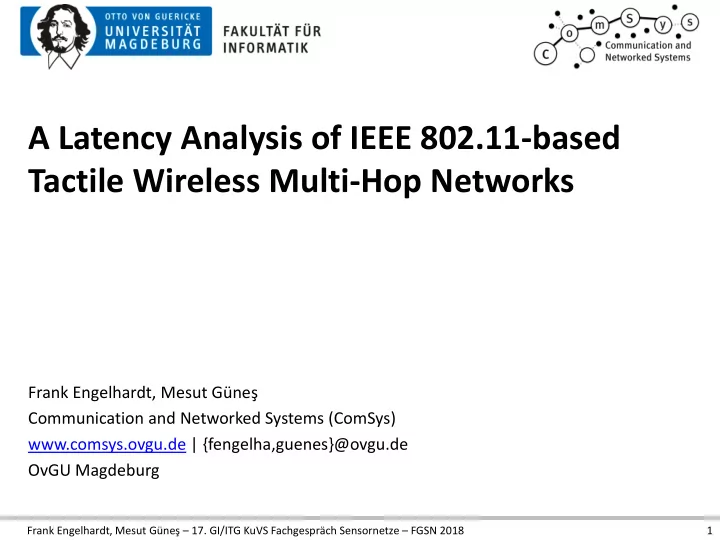

A Latency Analysis of IEEE 802.11-based Tactile Wireless Multi-Hop Networks Frank Engelhardt, Mesut Güneş Communication and Networked Systems (ComSys) www.comsys.ovgu.de | {fengelha,guenes}@ovgu.de OvGU Magdeburg Frank Engelhardt, Mesut Güneş – 17. GI/ITG KuVS Fachgespräch Sensornetze – FGSN 2018 1
Tactile Wireless Multi-Hop Networks • Tactile Internet (TI) requires ultra reliable, ultra low-latency networks • WMHN are more flexible than single-hop networks • 5G will introduce multi-hop characteristics through Device-2- Device, but question of performance is open • V2X, Teleoperation, Telesurgery , … Frank Engelhardt, Mesut Güneş – 17. GI/ITG KuVS Fachgespräch Sensornetze – FGSN 2018 2
Tactile Wireless Multi-Hop Networks Master 5G Networking Wireless Multi-Hop Network Slave TSE Latency Aijaz, A. et al., Realizing the tactile internet: Haptic communications over next generation 5g cellular networks, IEEE Wireless Communications 2017 Frank Engelhardt, Mesut Güneş – 17. GI/ITG KuVS Fachgespräch Sensornetze – FGSN 2018 3
Single-Flow Latency Model A haptic flow consists of • a sub-flow Master → Slave • another sub-flow Slave → Master Both sub-flows have the properties • 1 kHz packet rate • <100 Bytes per packet (e.g. 6*sizeof(float), a 6 DoF vector) • requires 1 ms latency bound Master Slave Control Data Flow H 1 R 1 R 2 ... R (h-1) H 2 Feedback Data Flow ... Hop: 1 2 3 h Frank Engelhardt, Mesut Güneş – 17. GI/ITG KuVS Fachgespräch Sensornetze – FGSN 2018 4
Single-Flow Latency Model • End-to-End latency 𝒆 𝒇𝟑𝒇 ~ 𝒊 = 𝒍 ∙ 𝒊 → Upper bound for h to reach latency requirement Master Slave Control Data Flow H 1 R 1 R 2 ... R (h-1) H 2 Feedback Data Flow ... Hop: 1 2 3 h Frank Engelhardt, Mesut Güneş – 17. GI/ITG KuVS Fachgespräch Sensornetze – FGSN 2018 5
Multi-Flow Latency Model • Multiple flows may cross at one or more routers → 𝑒 𝑓2𝑓 ~ ℎ is no longer true • E.g, a simple example with two flows crossing at router Rx H 1 H 4 R A R D R x R C R B H 3 H 2 Frank Engelhardt, Mesut Güneş – 17. GI/ITG KuVS Fachgespräch Sensornetze – FGSN 2018 6
Multi-Flow Latency Model cw s/r IFS aSlotTime Send H 2 → H 1 R B Receive H 1 → H 2 Send H 4 → H 3 R D Receive H 3 → H 4 Send H 1 → H 2 H 2 → H 1 H 3 → H 4 H 4 → H 3 R x Receive H 3 → H 4 H 1 → H 2 H 2 → H 1 H 4 → H 3 Send H 3 → H 4 R C Receive H 4 → H 3 Send H 1 → H 2 R A Receive H 2 → H 1 d max H 1 H 4 R A R D R x R C R B H 3 H 2 Frank Engelhardt, Mesut Güneş – 17. GI/ITG KuVS Fachgespräch Sensornetze – FGSN 2018 7
Multi-Flow Latency Model • Multiple flows may cross at one or more routers → 𝑒 𝑓2𝑓 = 𝑙 ∙ ℎ + 8 ∙ 𝑒 𝑄𝑙𝑢,𝑛𝑏𝑦 for this example → 𝑒 𝑓2𝑓 = 𝑙 ∙ ℎ + 4 ∙ 𝑜 ∙ 𝑒 𝑄𝑙𝑢,𝑛𝑏𝑦 for n intersecting flows H 1 H 4 R A R D R x R C R B H 3 H 2 Frank Engelhardt, Mesut Güneş – 17. GI/ITG KuVS Fachgespräch Sensornetze – FGSN 2018 8
Evaluation of Queueing Delay relative to n • We model an M/M/1 Queue for the sender of Rx • Unscheduled WiFi traffic, which has non-deterministic behavior • Average delay 𝒆 𝒃𝒘𝒉 = 𝝁 𝝁(𝝂−𝝁) with arrival rate 𝝁 and service rate 𝝂 • 𝝂 = 𝒔/𝒕 with transmission bit rate r, packet size s • 𝝁 = 𝟓 ∙ 𝒐 ∙ 𝝁 𝑮𝒎𝒑𝒙 , with the packet rate per flow 𝝁 𝑮𝒎𝒑𝒙 = 𝟐𝒍𝑰𝒜 • 𝒆 𝒃𝒘𝒉 (𝒐) = 𝟓∙𝒕∙𝒐∙𝝁 𝑮𝒎𝒑𝒙 𝒔 𝟑 −𝟓∙𝒔∙𝒐∙𝝁 𝑮𝒎𝒑𝒙 Frank Engelhardt, Mesut Güneş – 17. GI/ITG KuVS Fachgespräch Sensornetze – FGSN 2018 9
Evaluation • We consider three constellations: Q1, Q2, Q3 • 𝒆 𝒃𝒘𝒉 (𝒐) = 𝟓∙𝒕∙𝒐∙𝝁 𝑮𝒎𝒑𝒙 𝒔 𝟑 −𝟓∙𝒔∙𝒐∙𝝁 𝑮𝒎𝒑𝒙 • Linearization is possible, e.g. for n<14 for Q3! Frank Engelhardt, Mesut Güneş – 17. GI/ITG KuVS Fachgespräch Sensornetze – FGSN 2018 10
Concluding Remarks • Linearization could lead to a simple linear model for the entire network: 𝑒 𝐺𝑚𝑝𝑥,𝑏𝑤 𝑜, ℎ = 𝑙 1 ∙ ℎ + 𝑙 2 ∙ 𝑜 𝐺𝑚𝑝𝑥 , with 𝑜 𝐺𝑚𝑝𝑥 =number of concurrent flows intersecting the current flow • Model calibration based on simulation and also on real- hardware testbeds is ongoing work Frank Engelhardt, Mesut Güneş – 17. GI/ITG KuVS Fachgespräch Sensornetze – FGSN 2018 11
Recommend
More recommend